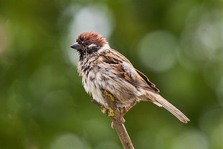

Biodiversity
Action
Plan
Buildings. A number of priority bird species utilise buildings and other built structures for nesting and roosting. These include House Sparrow and Starling, and the summer visitors Swift and House Martin. They can be helped by taking account of their needs in building design and maintenance and with nest boxes.
House Sparrow, a familiar, streaky brown bird, noisy and gregarious, often seen in our gardens, males have a grey cap and black bib.
House sparrows feed on a variety of foods, including buds, seeds, and scraps, and will visit bird tables and feeders.
A common resident breeding bird in Barnsley, it is found in built-up areas, in local villages, and in and around farm buildings, with several thousand breeding pairs.
Conservation measures
- Retain nest sites in the eaves of all buildings when re-roofing and modernising properties.
- Provide colonial nest boxes
Habitats
- Built environment
- Gardens and Parks
- Hedges
House Sparrows nest in holes or crevices in buildings. They also nest in ivy against walls and in thick hedges. They readily use nest boxes. They usually nest in loose colonies; nests can be as little as 20-30 cm apart.
The main nesting season is from April to August, with two or three broods. Young are initially fed on caterpillars, aphids, etc.
The precise reasons for the decline of House Sparrows are not yet known.
House Sparrow
UKBAP 2007 Priority Species
NERC Section 41 Species of Principal Importance
BoCC5 Red List
General protection W&C Act
Starlings, black with a sheen close up, are often in flocks: feeding, roosting or flying.
They feed on invertebrates such as leatherjackets and worms, as well as seeds later in the year.
They also feed on scraps and are use garden bird feeders.
Starlings are widespread in Barnsley, particularly in towns, villages and farm areas, with over 1000 pairs.
Starlings look for nest cavities early in the year, often in masonry or eaves of houses.
They take readily to nest boxes of suitable size with a 45mm entrance hole
Starlings breed from April to June, with one or two broods.
Their decline may be due to the loss of suitable nesting sites, of nearby foraging habitat and of invertebrate prey.
Starling
UKBAP 2007 Priority Species
NERC Section 41 Species of Principal Importance
BoCC5 Red List [IUNC2 VU]
General protection W&C Act
Swift, always in flight except at the nest, are seen flying fast, screaming loudly, or swooping to their nests in a building ,
Sooty-brown Swifts, have long, thin, curved blade-like wings and a short, forked tail.
They have very small bills but wide mouths, used to catch flying insects and airborne spiders on the wing.
They can cling to an upright surface but are unable to perch or walk.
Conservation measures
- Retain nest sites in eaves of buildings when re-roofing and modernising properties.
- Place sufficient swift nest boxes on eaves and swift bricks in new developments.
- Planning conditions to protect and provide nesting sites.
Habitats
- Built environment
Swift Conservation information
Swifts are summer visitors, here from May to early September, with a single brood
They nest in the eaves of houses or in cavities high up in buildings, but also nest in specially-designed nest-boxes.
In Barnsley there could be around 1000 pairs, often associated with older local authority housing estates.
Their presence depends on an abundance of aerial insects and access to nesting sites.
Swift
BoCC5 Red List [IUNC2 EN]
General protection W&C Act
House Martins spend much of their time on the wing catching insect prey; they also collect mud for nests.
They are blue-black above, white below, and show a forked tail and a white rump in flight.
They need abundant flying insect prey, available nest sites and areas of damp mud to thrive.
There are up to 500 pairs of House Martins in Barnsley in colonies of varying size.
Conservation measures
- Avoid nest destruction by householders, incl. after use.
- Retain nest sites in eaves when re-roofing properties.
- Provide artificial house martin nests
- Planning conditions to protect and provide nesting sites.
Habitats
- Built environment
- Wetland muddy areas
House Martins are a common summer visitor arriving in April and leaving in October. They may have two broods.
They build nests of mud under ledges, often the eaves of houses and other buildings, sometimes in small colonies.
They can make use of artificial nests.They often return to their nests year on year.
House Martin
BoCC5 Red List [IUNC2 NT]
General protection W&C Act
Barn Owls and Peregrine Falcons use buildings to nest, Barn Owls on ledges and cavities within buildings and Peregrines on ledges high up on the outside of buildings, like on a cliff face.
Conservation measures
- Retain areas of grass where starlings can forage
- Retain nest sites in eaves of buildings when re-roofing and modernising properties.
- Provide nest boxes and spaces in house eaves together with grassed areas in developments
Habitats
- Built environment
- Gardens and Parks
- Grassland pastures


Swift image required.

Birds using buildings